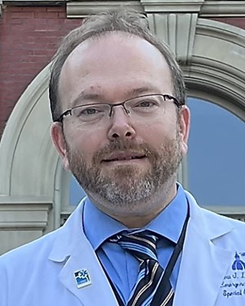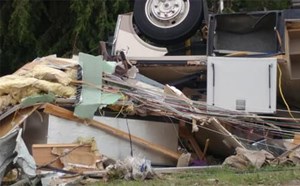
Active Shooter Disasters in the Hospital: An Expert’s View
Writer Lucinda Millsom interviews Dr. Matthew J. Levy, Deputy Director of Operational Medicine, Associate Professor of Emergency Medicine and Surgery, Johns Hopkins University School of Medicine.
Lucinda Millsom is a medical student who has completed her 3rd year clinical rotation at Swedish Covenant Hospital, Chicago, Illinois.
Matthew Levy, D.O., M.Sc.
Deputy Director of Operational Medicine
Associate Professor of Emergency Medicine and Surgery
Johns Hopkins University School of Medicine

Matthew Levy, D.O., M.Sc., FACEP, FAEMS, is an associate professor in the Department of Emergency Medicine and holds a leadership role in its Division of Special Operations. He is also a fellow of the American College of Emergency Physicians and a Fellow of the Academy of Emergency Medical Services. Dr. Levy works closely with multiple local, state, and federal emergency medical services, special operations medicine, and disaster medicine response elements.
Dr. Levy joined the faculty of the Johns Hopkins University School of Medicine in 2009. He completed his training in emergency medicine at The Johns Hopkins Hospital in 2009 after serving as chief resident (2008–2009). Dr. Levy’s research focuses on pre-hospital, operational, and disaster medicine. He is the medical director of Howard County Fire and Rescue and serves as a Regional Medical Director for the Maryland Institute for Emergency Medical Services Systems. Dr. Levy is a tactical physician with the Maryland State Police and Howard County Police. He is also the founding commander of the Maryland-1 Disaster Medical Assistance Team and the medical director of the paramedic program at the University of Maryland, Baltimore.
We asked Dr. Levy about his firsthand experience of active shooter disasters and how to improve hospital campus safety.
Q. Can you discuss your experience working with local, state, and federal emergency medical services, special operations medicine, and disaster medicine response elements?
A. “I started my medical career as an EMS clinician, educator, and now EMS and tactical physician and medical director. These experiences have given me insight and perspective on the stresses and challenges of real-world responses. My other roles, including being a response team member and operational physician, have helped me appreciate the nuances and complexities of multi-agency responses related to prolonged and complex incidents.”
Q. How has your background as a tactical physician informed your approach to disaster emergency medicine and hospital shooting incidents?
A. “The basic principles of trauma care that we now consider standard practice, particularly early hemorrhage control and management of torso injuries for penetrating trauma, were first translated from military practice to the tactical medicine community. As we implemented these practices in the civilian tactical medical community, we began seeing the impact and value of these interventions. We realized the need and opportunity to mainstream these interventions for all emergency medicine and emergency medical services. Hospital and healthcare shooting events are unique for several reasons; one of the most obvious is that in the healthcare setting, there’s an assumption that since medical personnel are often immediately available, people will know how to manage a casualty. However, we know that successful response to active assailant events and the effective management of traumatically injured casualties requires a prompt and systematic approach to care with a focus on life-threatening injuries. This approach is grounded in having a clear understanding of roles, responsibilities, and associated actions to be taken by response team members. We also know the importance of not just having a plan, but also exercising and testing that plan through a combination of table-top exercises, drills and simulations.”
Q. Can you describe any particularly challenging incidents or cases you have been involved with in your work as a medical director of Howard County Fire and Rescue and as a Regional Medical Director for the Maryland Institute for Emergency Medical Services Systems?
A. “My experiences regarding active assailant/shooting event response are similar to others, with many (but not all) of these situations being over relatively quickly and being followed by a complex and robust law enforcement response. My first-hand experience as a responder to an active assailant relatively early in my career as a medical director left me with an appreciation for the multiple priorities facing responders and public safety leadership during these events and the complexities associated with the response. “
Q. What are some common mistakes or oversights that hospitals make when it comes to preventing and preparing for active shooter incidents?
A. “Many healthcare systems have initially appropriately focused on immediate mitigation strategies (run, hide, fight, etc.) during such a response. However, I’ve observed a gap in the next phase of active assailant response planning. I think there’s a real opportunity for well-trained and exercised internal quick response resources that can readily collaborate with law enforcement upon their arrival. This has already been done at certain facilities around the country. The other item I’ve observed is that when drills are conducted, there’s often an artificiality to them (things being “out of play” etc), and I worry if not properly addressed, this can cause a false confidence, or in some cases a training scar, that may ultimately impede a real-world incident response.”
Q. What role do you believe emergency physicians can play in promoting hospital campus safety and preventing active shooter incidents?
A. “As EM physicians, we are well positioned to serve as leaders and collaborators for hospital active assailant incident preparedness. At a minimum, Emergency Medicine needs to have a seat at the institutional planning table, but ideally, we should be in a leadership role regarding planning, readiness, and preparedness. We should also be looking inward within our own EDs as to how to improve readiness for a surge of causalities from an external assailant event as well.”
Q. How should healthcare facilities approach training and educating their staff on active shooter preparedness and response? Do you have any advice on best practice models that hospitals should emulate?
A. “Like other preparedness activities, facility-wide training, and education, often necessitates there be layers of training that span all personnel (both clinical and nonclinical), along with specialized training for personnel in specific job roles. This is likely a blend of both asynchronous (online) and in-person task-specific training. It’s also important that we embrace best-practices for low-frequency, high-consequence events and look to training models that include shorter-duration, more frequent trainings.”
Q. How can healthcare facilities work with local law enforcement and emergency response agencies to improve their active shooter prevention and response capabilities?
A. “If your facility has not yet established a workgroup/collaborated with local law enforcement and public safety, I’d say that’s the most important place to start. If such a group exists, ensure that it meets with a frequency often enough to review policy, conduct needs/gap analyses, and review lessons learned and plan exercises. From an operational perspective, public safety personnel should have a working familiarity with the physical layout of facility/campus. This group should have an active and ongoing dialog.”
Q. Finally, what advice would you give to emergency physicians and other healthcare professionals who want to be more involved in promoting hospital campus safety and preventing active shooter incidents?
A. “A great place to start is to reach out to the leadership personnel at your institution and simply offering to help. From there, you’ll likely be asked to help with a specific project. Avoid the temptation to reinvent the wheel: There are many excellent online resources from government and professional organizations to help guide you. Lastly, don’t forget about your EM colleagues across the country. Reach out through list serves, social media and other means. Chances are that someone has been in your situation and can share insights.”



